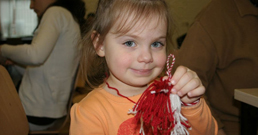24.3.2014
Iliyana Bozhova*
The date 1st of March holds a special place with the Bulgarian people as on that date they celebrate the coming of the spring. The common greeting they exchange is Chestita Baba Marta or “Happy Grandma Marta”. Grandma Marta symbolizes the month of March and the revival of nature. The unpredictable spring weather was attributed to her changing moods. In the popular belief, the old lady had two brothers Big Sechko(January) and Small Sechko(February), who drank all her wine and made her angry, which caused a storm. Then she decided to forgive them, smiled and the weather became warm again.
On this day along with greeting each other, the Bulgarians exchange small adornments called “martenitsas”. They are made out of twisted red and white yarn threads and are believed to bring good health for the rest of the year. The colours have a symbolic meaning - red is the colour of health, strength and blood and white - of long life, purity and happiness. The form of the martenitsa varies; it can be a bracelet, a necklace or a brooch but the most famous one consists of two small dolls – a white boy and a red girl called Pizho and Penda. Walking down the streets of Bulgaria during March you will inevitably notice the Pizho and Penda martenitsa hanging on people’s coats. Regardless of age, gender or marital status everyone has one. However, that was not the case in the past when martenitsas adorned only the children’s hands and the unmarried or newly married women’s necks. They were also placed on fruit-trees and newly born domestic animals with the hope that the new year would be fertile and prosperous and would bring good health and happiness.
The craft of making martenitsa has survived for centuries in the Bulgarian households and its origin can be traced back to the pre-Christian period in the country. According to tradition the oldest woman in the family prepared the martenitsas one night before the 1st of March. It was a requirement that she had not touched any fire beforehand as otherwise the martenitsa would have lost its magical power to protect against evil eyes, spirits and diseases. The martenitsas are worn until the first signs of spring appear. If someone gives you a martenitsa you are supposed to take it off after you see a stork, swallow or a cuckoo, and put it on a blooming fruit-tree.
This tradition has lived for centuries until the present day. However, it has now become highly commercialized. A few weeks before March the streets are full of stalls with a variety of martenitsas. Moreover, in most Bulgarian schools special workshops are organized where the pupils produce their own handmade martenitsas. One such example is the Bulgarian school in Leiden "St. Cyrilus and Methodius", where these annual workshops have become a traditional event. In the slideshow on this page we visit this school while the children, their teachers and parents are preparing their martenitsas in their annual spring workshop.
The pictures of the Bulgarian school are taken by Radostina Sharenkova.
* Iliyana Bozhova is a student of Persian studies at Leiden University.
 Like us on Facebook
Like us on Facebook
Share this story



